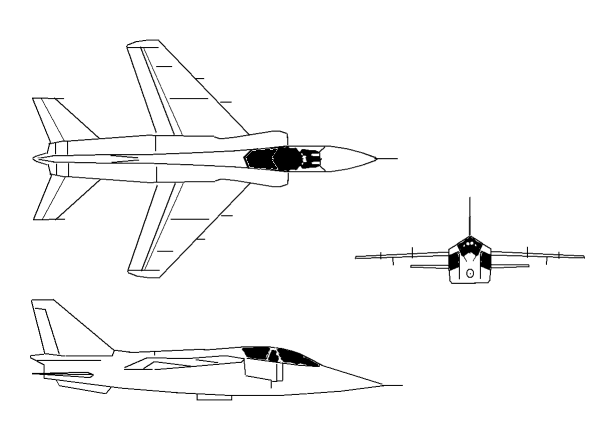



AVIOANE J-22 Orao (Eagle)
The Orao is a twin-engine, turbojet, high-wing aircraft intended for performing tactical assault missions within the zone of the front and also in the enemy rear. It is manufactured in single-seater (J-22) and two-seater (NJ-22) versions and as a single-seater (IJ-22) and two-seater (INJ-22) reconnaissance plane, though the latter's engine does not have afterburning. The wing is trapezoidal, swept-back, low thickness ratio with pronounced strakes (hybrid wings). The propulsion system consists of two single-shaft Rolls-Royce turbojet engines in the Viper family.
The engines are located side by side, in the rear section of the fuselage.
Following the Yugoslav aircraft industry's success in the 1970's with the G-2 Galeb [Sea Gull] and J-1 Jastreb [Hawk] airplanes, attention turned to
designing a more up-to-date combat aircraft to replace the F-84 Thunderjet in supporting the fleet of Jastreb light assault planes. Romania, intending to replace older models of the MiG-17, soon joined the new effort in 1970.
The joint program was given the name YUROM (YUgoslavia-ROMania).
The program called for a transonic twin-engine plane, intended for support of units at the front and for assault operations, that would be simple to operate and easy to maintain. A secondary role was envisaged as a fighter-interceptor in combating helicopters, transport planes, and fighter-bombers. The series 600 Viper engines of Rolls-Royce were chosen for the
power plant.
The prototypes took off for the first time, one in
Yugoslavia and the other in Romania, on 31 October 1974. The Yugoslav aircraft was christened the Orao, while in Romania the plane was given the designation IAR-93.
In series production the plane was designated the J-22, with
NJ-22 for the two-seater version.
For self-defense of the aircraft the arsenal of weapons has been bolstered with short-range air-to-air missiles with infrared homing, which are
installed on two new armament lines on the wingtips, each with a
carrying capacity of 100 kg. The assortment of
weapons has also been broadened with laser, antiradar, and
antiship missiles and short-range air-to-air projectiles. Armament includes two twin-barrel GS-23L 23-mm cannon with 200 rounds each. The maximum weapon-carrying capacity is 2,800 kg.
Specifications
|
| Length |
42 ft 8 in / 13.02 m |
| Wingspan | 30 ft 6 in / 9.3 m |
| Height | 14 ft 10 in / 4.52 m |
| Weight - Empty | 12,676 lb / 5,750 kg |
| Weight Max T/O | 24,030 lb / 10,900 kg |
| Max Speed |
702 mph |
| Range |
712 nm |
| Powerplant |
two Viper Mk 632-47 w/ afterburner |
| Thrust |
8,000 lb 10,000 lb w/ afterburner |
| Armament |
five hardpoints-6,173 lbtwo 23mm twin GSh-23L cannon
bombs rockets |


Sources and Resources
- J-22 Orao Yugoslavia Air and Air Defence Force @ Scramble
- "Assault Plane in Our Sky" by Aleksandar Mikic Belgrade VOJSKA 07 July 1994 pp 30-33 [Data on J-22 Orao Aircraft : FBIS-EEU-94-195 -- 11/12/95]
http://www.fas.org/man/dod-101/sys/ac/row/j22.htm
Maintained by Robert Sherman
Originally created by John Pike
Updated Thursday, March 11, 1999 7:47:49 PM





